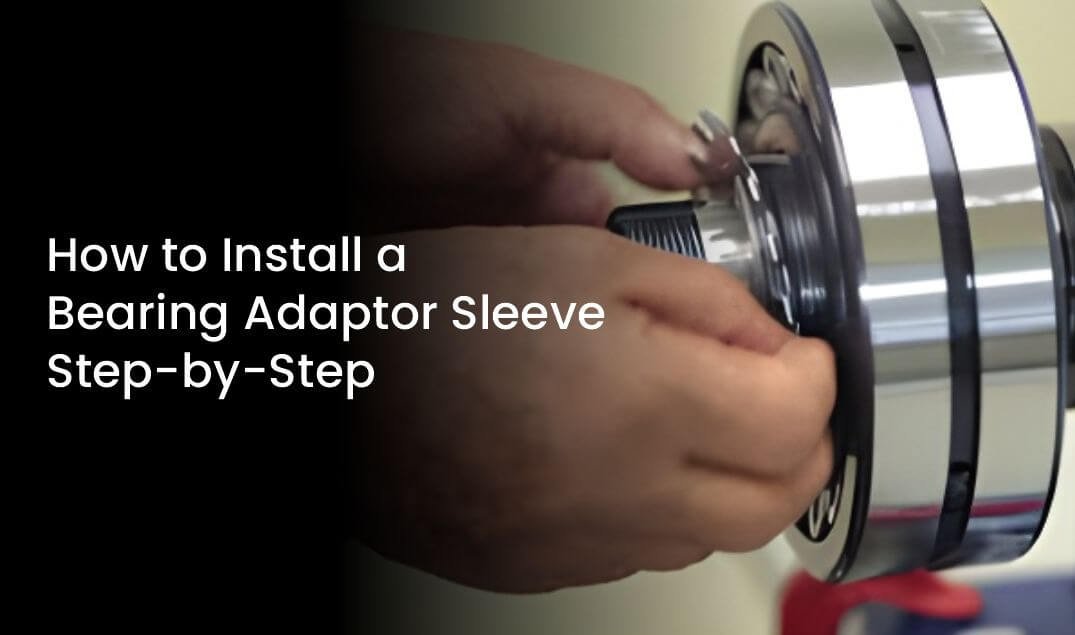
Bearing adaptor sleeves are indispensable in mechanical systems across India, from heavy machinery in manufacturing plants to agricultural equipment in rural areas. These components simplify the process of mounting bearings with tapered bores onto cylindrical shafts, ensuring alignment and operational efficiency. But a key question arises in maintenance and procurement circles: are bearing adaptor sleeves reusable, or should they be replaced after each use? This article delves into the factors influencing their reusability, scenarios requiring replacement, and practical tips for maintenance, tailored to the needs of Indian industries.
What Are Bearing Adaptor Sleeves?
Bearing adaptor sleeves, often referred to as adapter bearing sleeves, are precision-engineered components used to mount bearings with tapered bores onto cylindrical shafts. They consist of a tapered inner bore, a cylindrical outer surface, a locknut, and a locking washer or clip. These sleeves allow for easy installation and removal of bearings without the need for complex machining of the shaft. In India, where industries like automotive, cement, and textiles rely heavily on rotating machinery, adapter sleeves are widely used due to their versatility and cost-effectiveness.
The primary function of an adapter sleeve is to provide a secure and concentric fit between the bearing and the shaft. By tightening the locknut, the sleeve contracts around the shaft, creating a firm grip that ensures the bearing remains stable during operation. This design makes them particularly valuable in applications where shafts may not have a tapered profile or where frequent bearing replacement is required.
Factors Determining Reusability
Whether a bearing sleeve adapter can be reused depends on several factors, including material quality, operating conditions, and maintenance practices. Let’s explore these in detail:
1. Material and Manufacturing Quality
The durability of an adapter sleeve is heavily influenced by the quality of the material used in its construction. Most sleeves are made from high-grade steel or alloy materials designed to withstand significant mechanical stress. In India, where cost considerations often drive purchasing decisions, opting for high-quality sleeves can enhance their reusability. Poor-quality sleeves may deform or develop micro-cracks under stress, rendering them unsuitable for reuse.
2. Operating Conditions
The environment in which the sleeve operates plays a significant role. Harsh conditions, such as high temperatures, heavy loads, or exposure to corrosive substances, can accelerate wear and tear. For instance, in industries like steel manufacturing or mining, where equipment is subjected to extreme conditions, adapter sleeves may experience surface damage or deformation, making replacement more likely than reuse.
3. Installation and Removal Practices
Proper installation and removal techniques are crucial for preserving the integrity of adapter bearing sleeves. Incorrect installation, such as over-tightening the locknut, can cause deformation or damage to the sleeve’s internal surface. Similarly, improper removal methods, like using excessive force, can lead to scratches or dents. In Indian workshops, where skilled labour may sometimes be limited, ensuring proper training for technicians can significantly extend the lifespan of these components.
4. Wear and Tear
Even with high-quality materials and careful handling, adapter sleeves are subject to wear over time. Regular inspections can help determine if the sleeve shows signs of fatigue, such as surface pitting, corrosion, or dimensional changes. If the sleeve retains its structural integrity and meets dimensional tolerances, it can often be reused.
When Should You Reuse a Bearing Adaptor Sleeve?
Reusing a bearing sleeve adapter is often a cost-effective option, especially in industries where operational budgets are tightly managed. However, reuse is only advisable under specific conditions:
- Minimal Wear: If inspections reveal no significant wear, such as scratches, dents, or corrosion, the sleeve can likely be reused. Non-destructive testing methods, such as visual inspection or ultrasonic testing, can help assess the sleeve’s condition.
- Proper Cleaning and Maintenance: Before reuse, the sleeve must be thoroughly cleaned to remove contaminants like dirt, grease, or rust. In India, where dust and humidity can affect equipment, proper cleaning protocols are essential.
- Compatibility with New Bearings: The sleeve must be compatible with the new bearing in terms of size and taper. Any mismatch can lead to improper fitting and operational inefficiencies.
- No History of Overloading: If the sleeve has been subjected to excessive loads or shock, it may have internal stresses that compromise its reliability. In such cases, reuse is risky.
For example, in small-scale industries across India, such as textile mills or agricultural equipment repair shops, technicians often reuse adapter sleeves after careful inspection to reduce costs. However, this practice requires a thorough understanding of the sleeve’s condition to avoid compromising machinery performance.
When Should You Replace a Bearing Adaptor Sleeve?
While reusing adapter sleeves can save costs, there are scenarios where replacement is the safer and more practical choice:
- Visible Damage: Any signs of physical damage, such as cracks, dents, or significant corrosion, indicate that the sleeve should be replaced. Damaged sleeves can lead to misalignment or bearing failure, which could result in costly downtime.
- Dimensional Changes: If the sleeve’s dimensions have altered due to wear or deformation, it will not provide a secure fit for the bearing. Precision is critical in applications like conveyor systems or heavy machinery, common in Indian industries.
- Frequent Failures: If a sleeve has been reused multiple times and the machinery experiences recurring issues, such as vibration or overheating, it may be time to replace the sleeve to ensure reliability.
- High-Stakes Applications: In critical applications, such as power generation or aerospace, where safety and performance are non-negotiable, replacing the sleeve with a new one is often recommended to eliminate any risk.
In India, where industries often balance cost and performance, the decision to replace an adapter sleeve may also depend on availability and lead times. Maintaining a stock of high-quality spares can help reduce downtime in such cases.
Best Practices for Maintenance and Inspection
To maximize the lifespan of bearing adaptor sleeves and make informed decisions about reuse or replacement, follow these maintenance practices:
1. Regular Inspections
Conduct routine inspections using tools like calipers, micrometers, or non-destructive testing equipment to check for wear, corrosion, or dimensional changes. In Indian industries, where equipment may run for extended periods, scheduling regular maintenance can prevent unexpected failures.
2. Proper Cleaning
Clean the sleeve thoroughly after removal to remove contaminants. Use appropriate solvents and ensure the sleeve is dried properly to prevent rust, especially in humid regions like coastal India.
3. Correct Installation Techniques
Follow manufacturer guidelines for installing adapter bearing sleeves. Use torque wrenches to apply the correct tightening force to the locknut, avoiding over-tightening that could deform the sleeve.
4. Storage Conditions
Store spare sleeves in a dry, dust-free environment to prevent corrosion. In India, where monsoon seasons can increase humidity, using moisture-resistant packaging or desiccants can help preserve sleeve quality.
5. Documentation
Maintain records of each sleeve’s usage history, including the number of times it has been reused and the conditions it was subjected to. This data can guide decisions about reuse or replacement.
Cost Considerations in the Indian Context
In India, cost is a significant factor in industrial decision-making. Reusing adapter sleeves can reduce expenses, particularly for small and medium enterprises (SMEs) in sectors like agriculture, textiles, or automotive repair. However, the cost of reuse must be weighed against the potential risks of equipment failure. A failed sleeve can lead to bearing damage, machinery downtime, and lost productivity, which could far outweigh the savings from reuse.
On the other hand, replacing sleeves regularly may increase upfront costs but can enhance reliability and reduce maintenance expenses in the long run. For large-scale industries, such as cement or steel plants, investing in high-quality adapter sleeves and maintaining a stock of spares can ensure operational continuity.
Conclusion
The decision to reuse or replace bearing adaptor sleeves depends on a careful assessment of their condition, operating environment, and application requirements. In India, where industries strive to balance cost and performance, proper maintenance and inspection practices are key to maximizing the lifespan of adapter bearing sleeves. By understanding the factors that affect reusability and following best practices, businesses can make informed decisions that optimize both cost and reliability. Whether you choose to reuse or replace, prioritizing quality and precision will ensure the smooth operation of your machinery.

